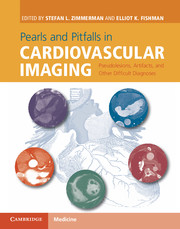 Pearls and Pitfalls in Cardiovascular Imaging
Pearls and Pitfalls in Cardiovascular Imaging from Section 9 - Mesenteric vascular
Published online by Cambridge University Press: 05 June 2015
Imaging description
Superior mesenteric artery syndrome is usually evaluated by contrast-enhanced CT or magnetic resonance angiography (MRA). The classic imaging finding is reduced space between the superior mesenteric artery and the anterior wall of the abdominal aorta that results in duodenal narrowing. The aortomesenteric angle, obtained from sagittal images, is significantly reduced from the normal range of 38–65°. The combination of an aortomesenteric angle less than 22° and an aortomesenteric distance of less than 8–10 mm is considered by some authors to meet criteria for the diagnosis of SMA syndrome in the right clinical setting on CT (Figure 80.1). Additional supportive findings include minimal intra-abdominal and retroperitoneal fat, duodenal compression between the aorta and SMA, dilation of the first and second portions of the duodenum, left renal vein enlargement, and enlargement of the left gonadal vein or other venous collaterals as a result of chronic renal vein compression (Figure 80.1).
Importance
Young age and non-specific symptoms often lead to a delay in diagnosis, resulting in complications such as malnutrition, dehydration, and electrolyte abnormalities in patients with SMA syndrome.
Typical clinical scenario
Superior mesenteric artery (SMA) syndrome is an atypical cause of high intestinal obstruction, with estimated incidence rates based on gastrointestinal barium series from 0.01% to 0.33%. It occurs from an abnormally short distance between the aorta and SMA from loss of intra-abdominal fat, which normally separates them resulting in duodenal compression and is an important differential in patients with postprandial abdominal pain, vomiting, and weight loss. The most common predisposing factors include severe weight loss and cachexia, surgical correction of spinal deformities, and congenital anomalies. Patients with recent bariatric surgery, cancer, or chronic immobilization are at risk.
Common symptoms include intermittent epigastric pain, which is often postprandial, early satiety, nausea, fullness, and voluminous vomiting, most frequently occurring in patients who have experienced rapid weight loss.
To save this book to your Kindle, first ensure [email protected] is added to your Approved Personal Document E-mail List under your Personal Document Settings on the Manage Your Content and Devices page of your Amazon account. Then enter the ‘name’ part of your Kindle email address below. Find out more about saving to your Kindle.
Note you can select to save to either the @free.kindle.com or @kindle.com variations. ‘@free.kindle.com’ emails are free but can only be saved to your device when it is connected to wi-fi. ‘@kindle.com’ emails can be delivered even when you are not connected to wi-fi, but note that service fees apply.
Find out more about the Kindle Personal Document Service.
To save content items to your account, please confirm that you agree to abide by our usage policies. If this is the first time you use this feature, you will be asked to authorise Cambridge Core to connect with your account. Find out more about saving content to Dropbox.
To save content items to your account, please confirm that you agree to abide by our usage policies. If this is the first time you use this feature, you will be asked to authorise Cambridge Core to connect with your account. Find out more about saving content to Google Drive.